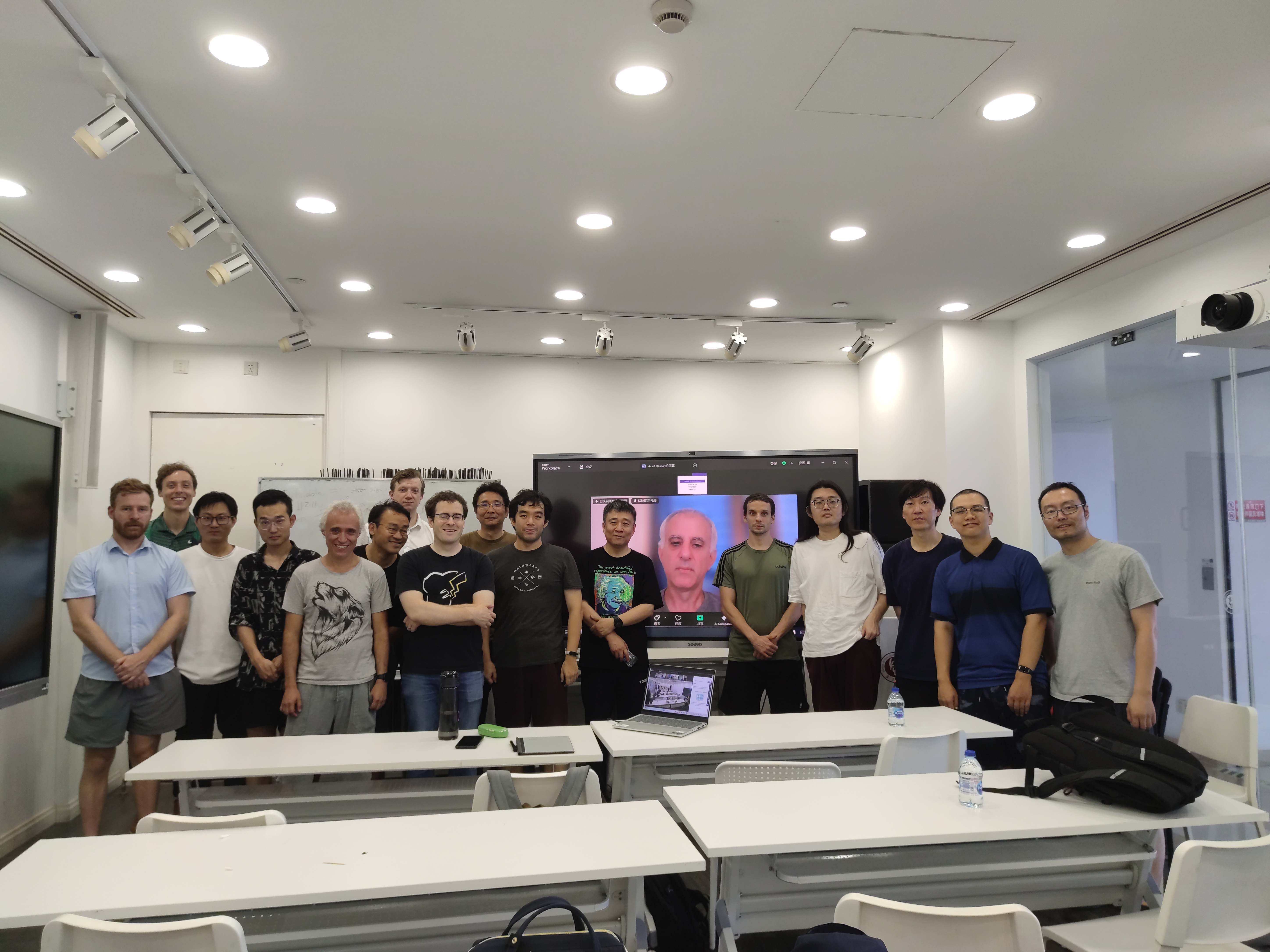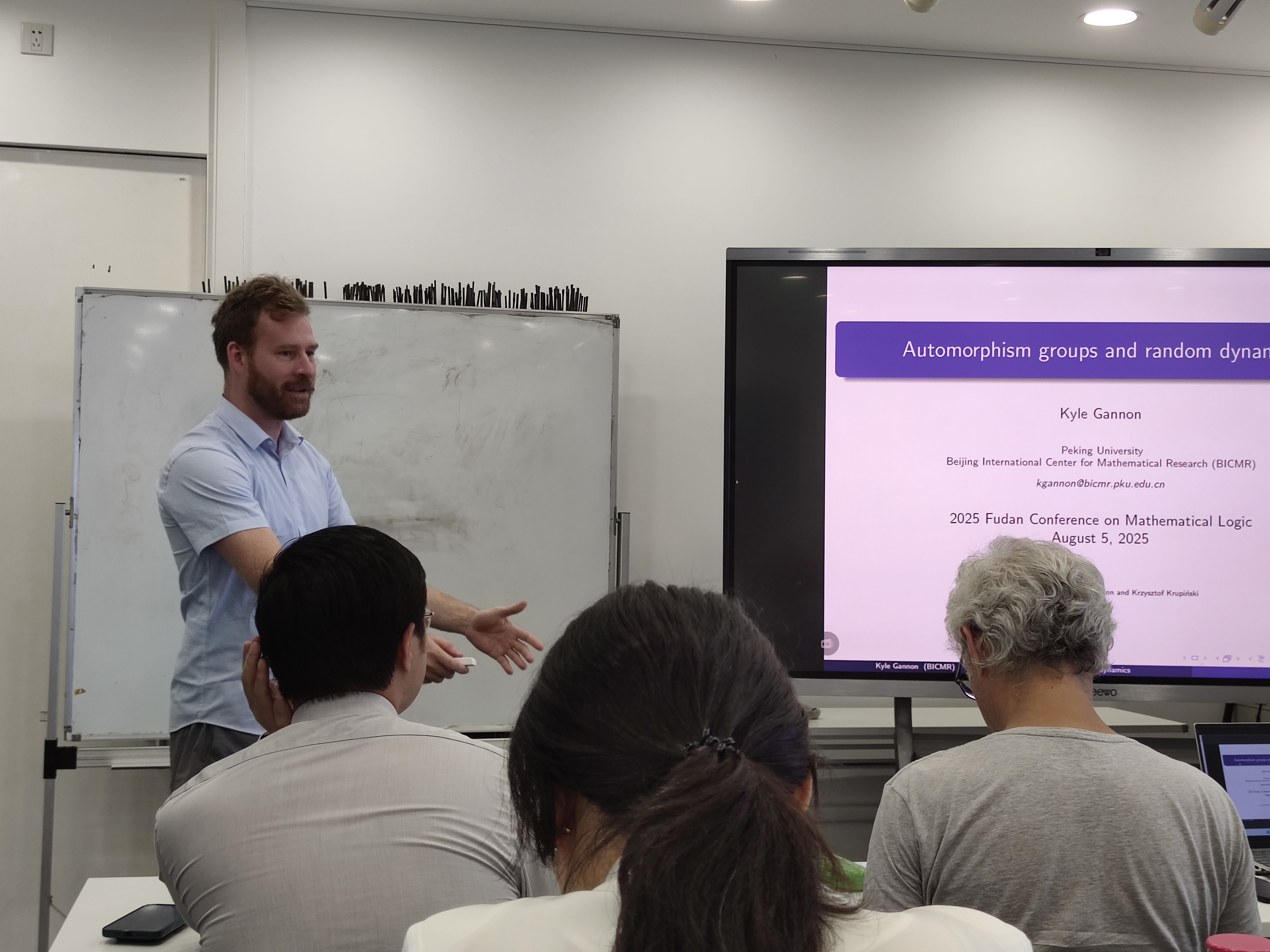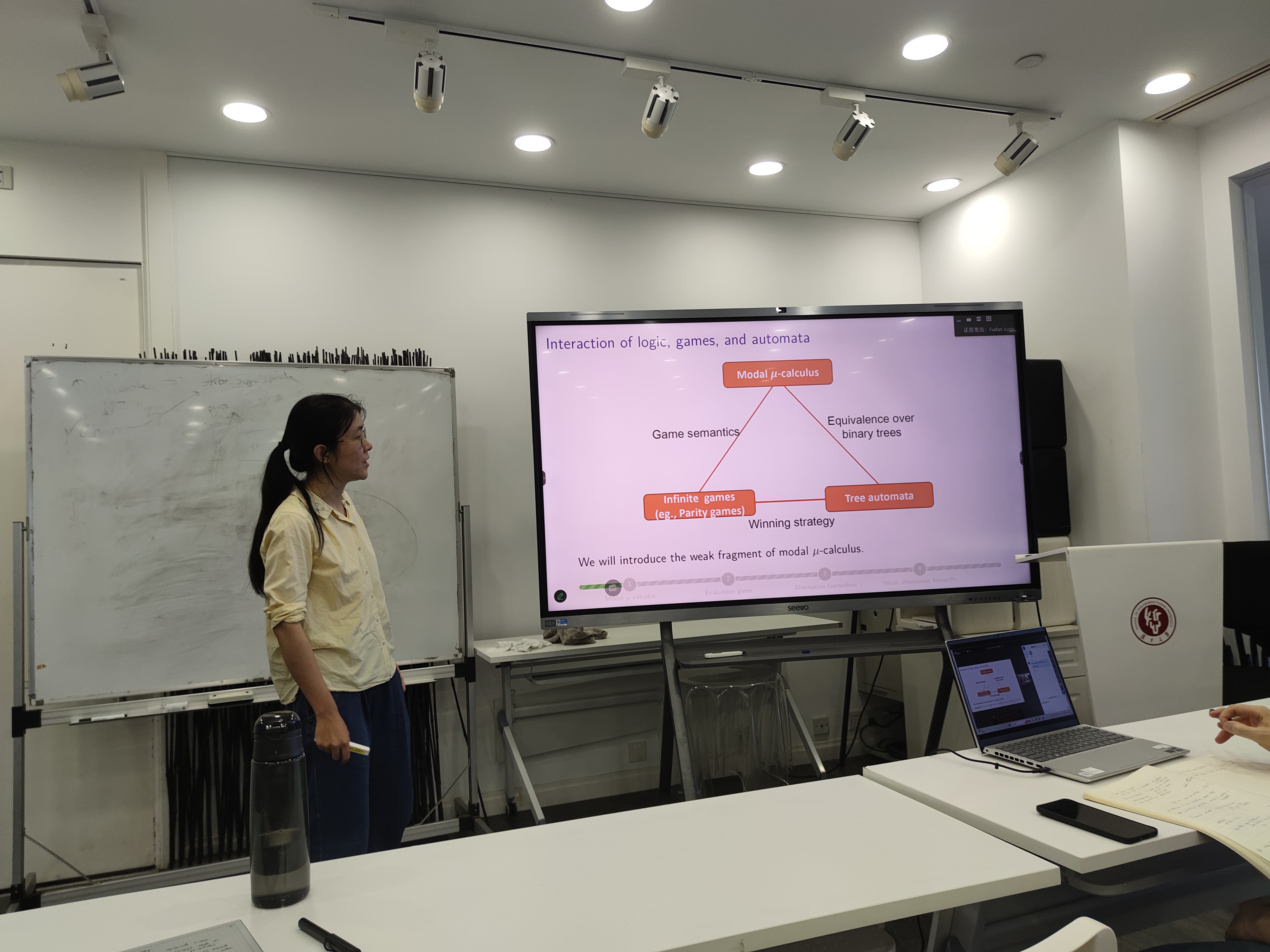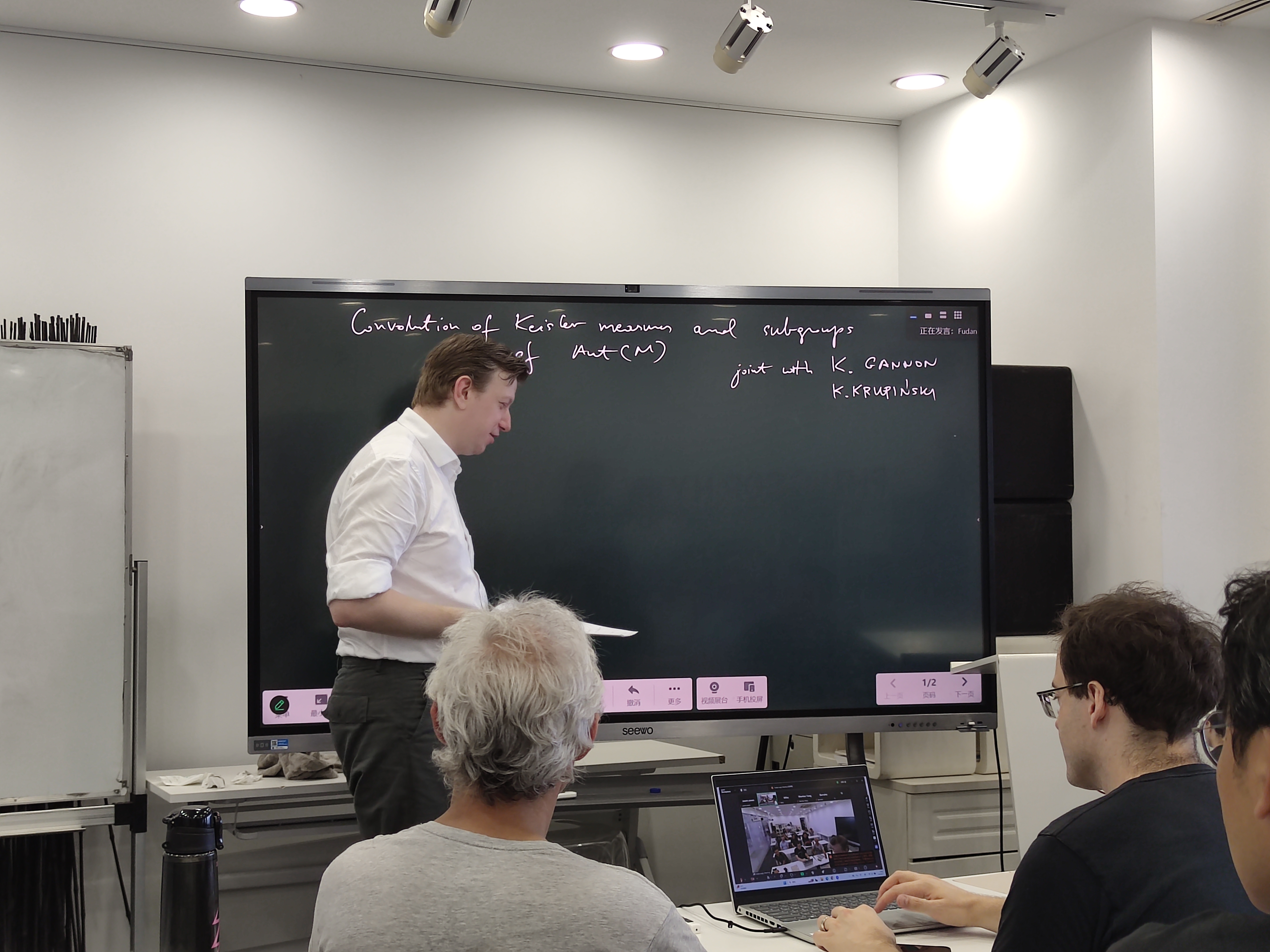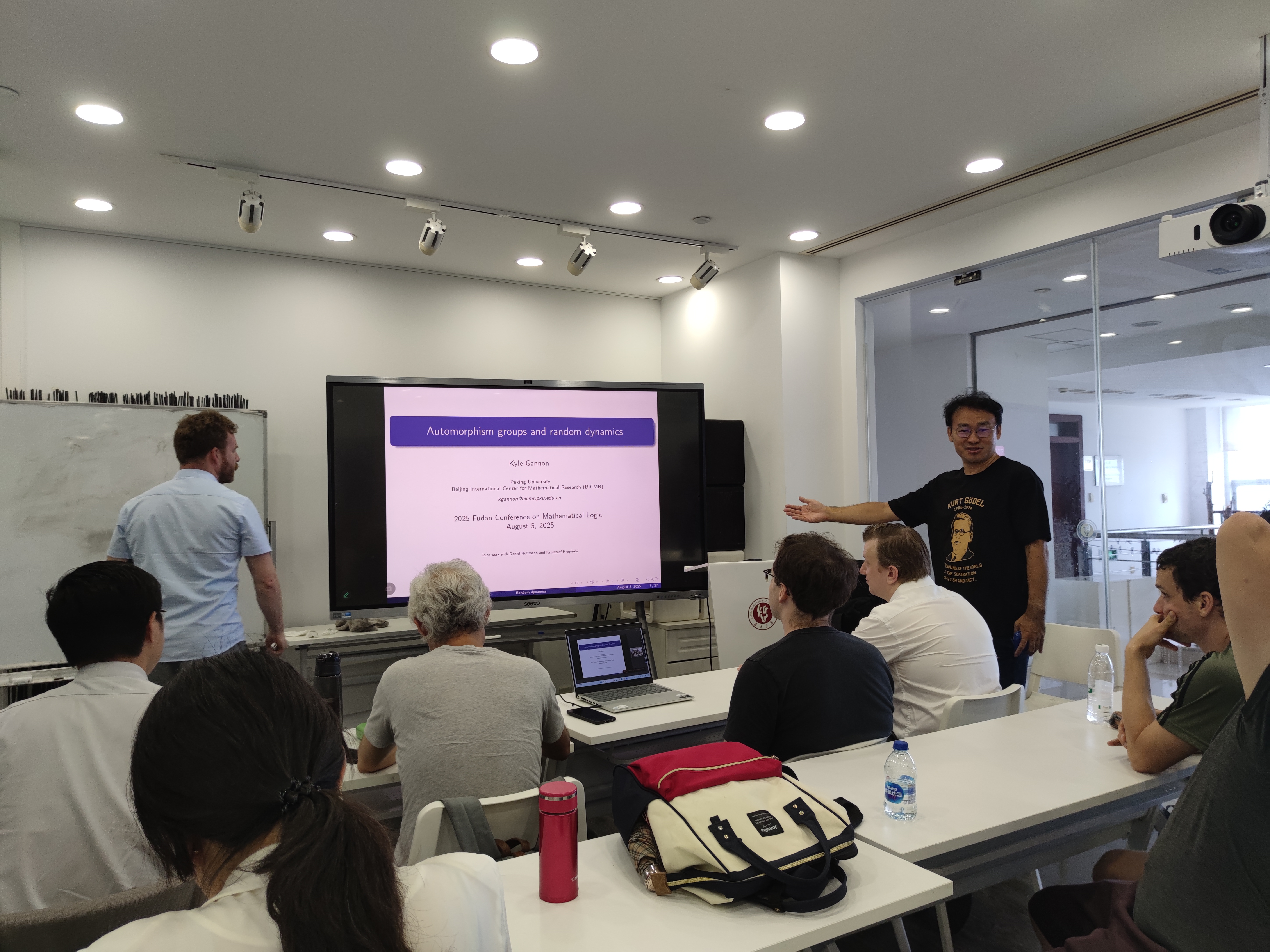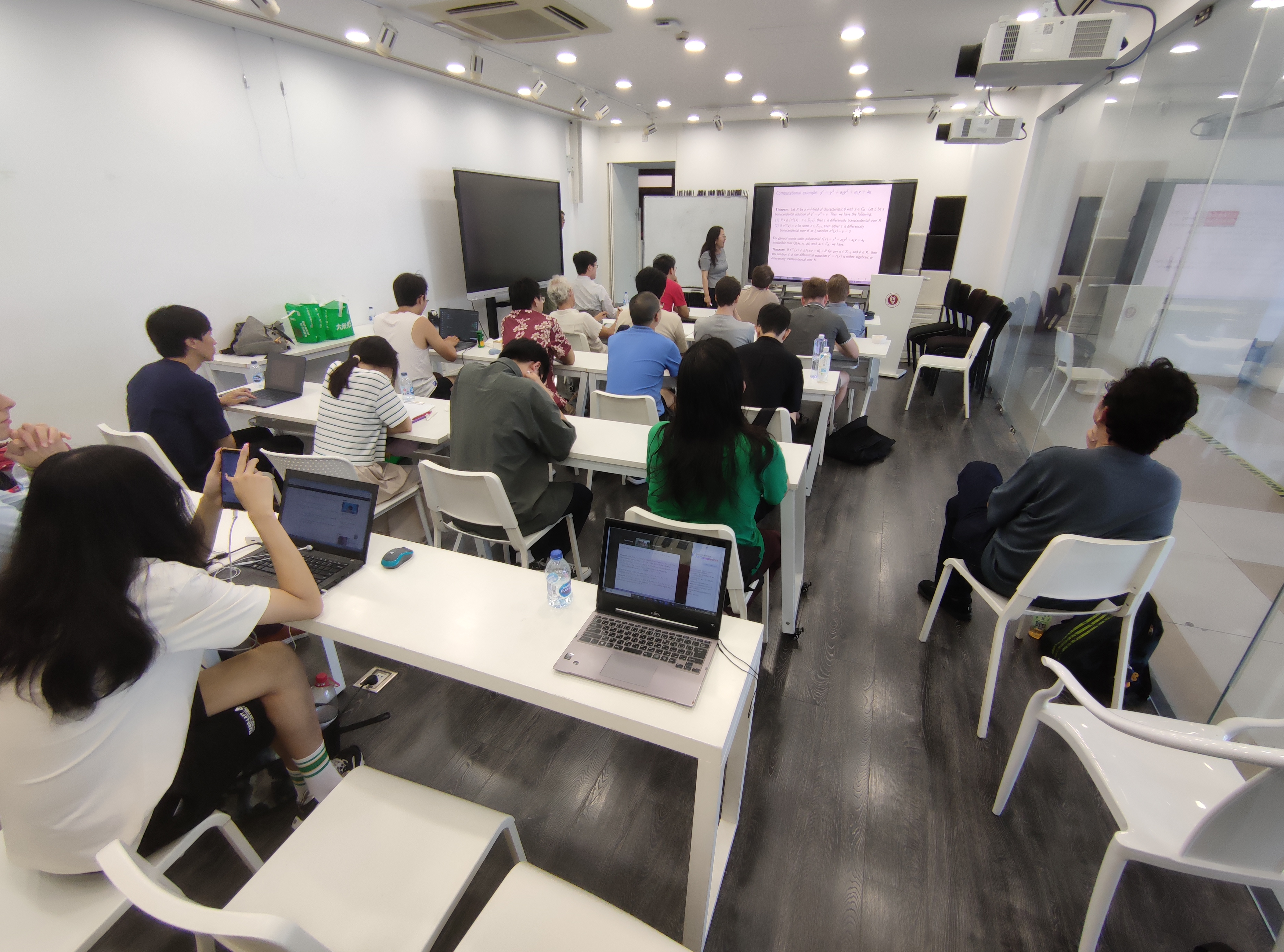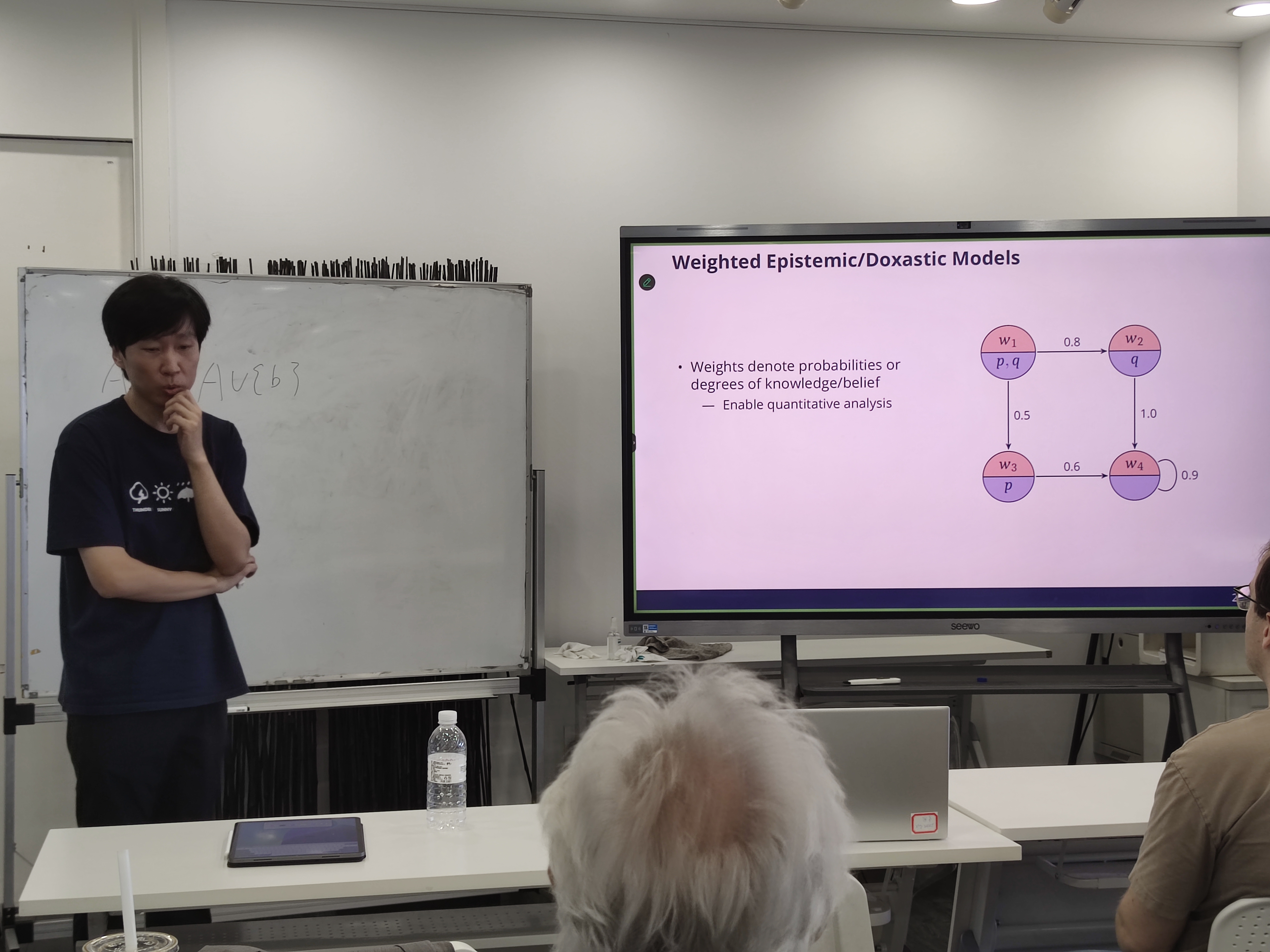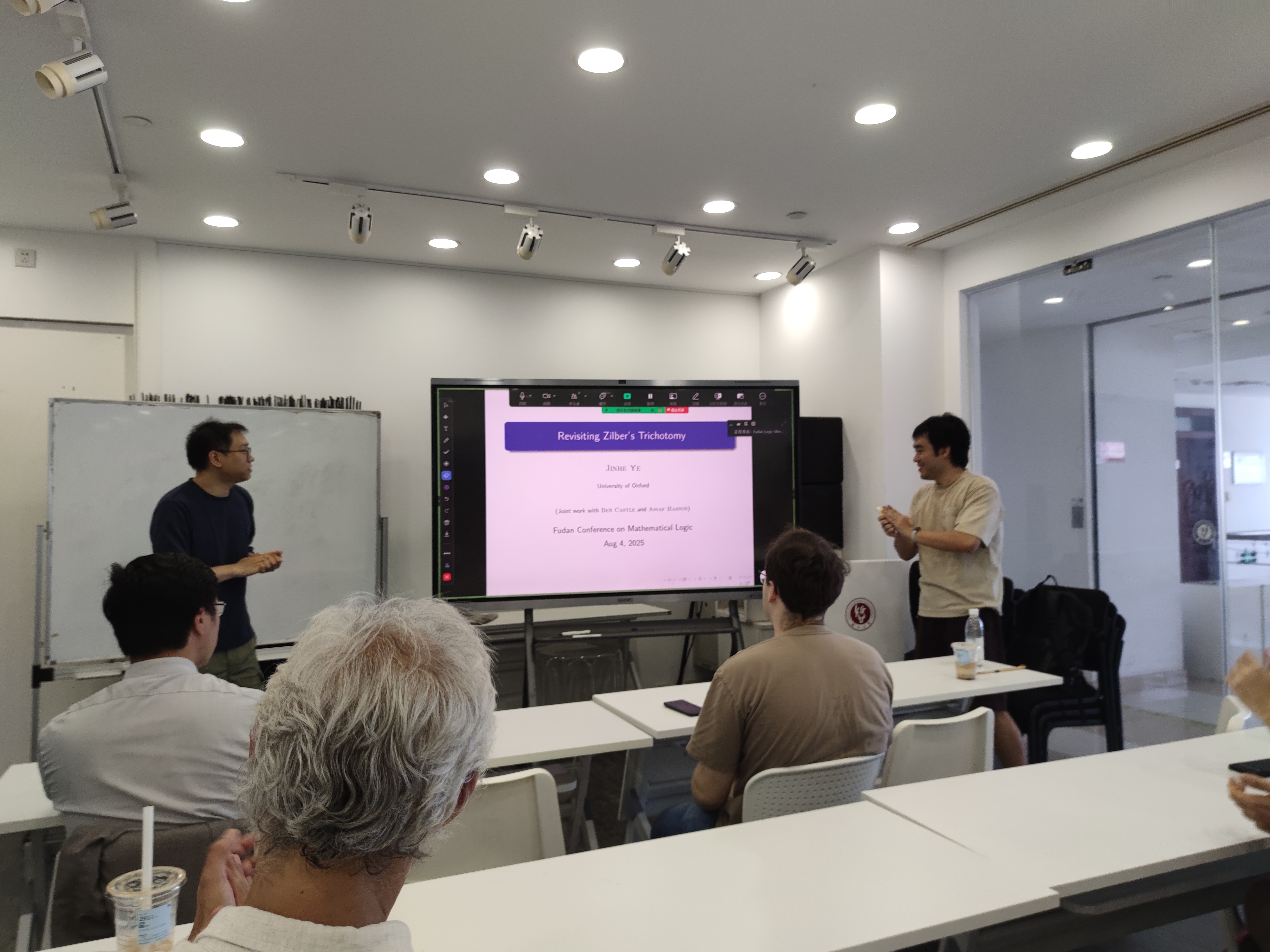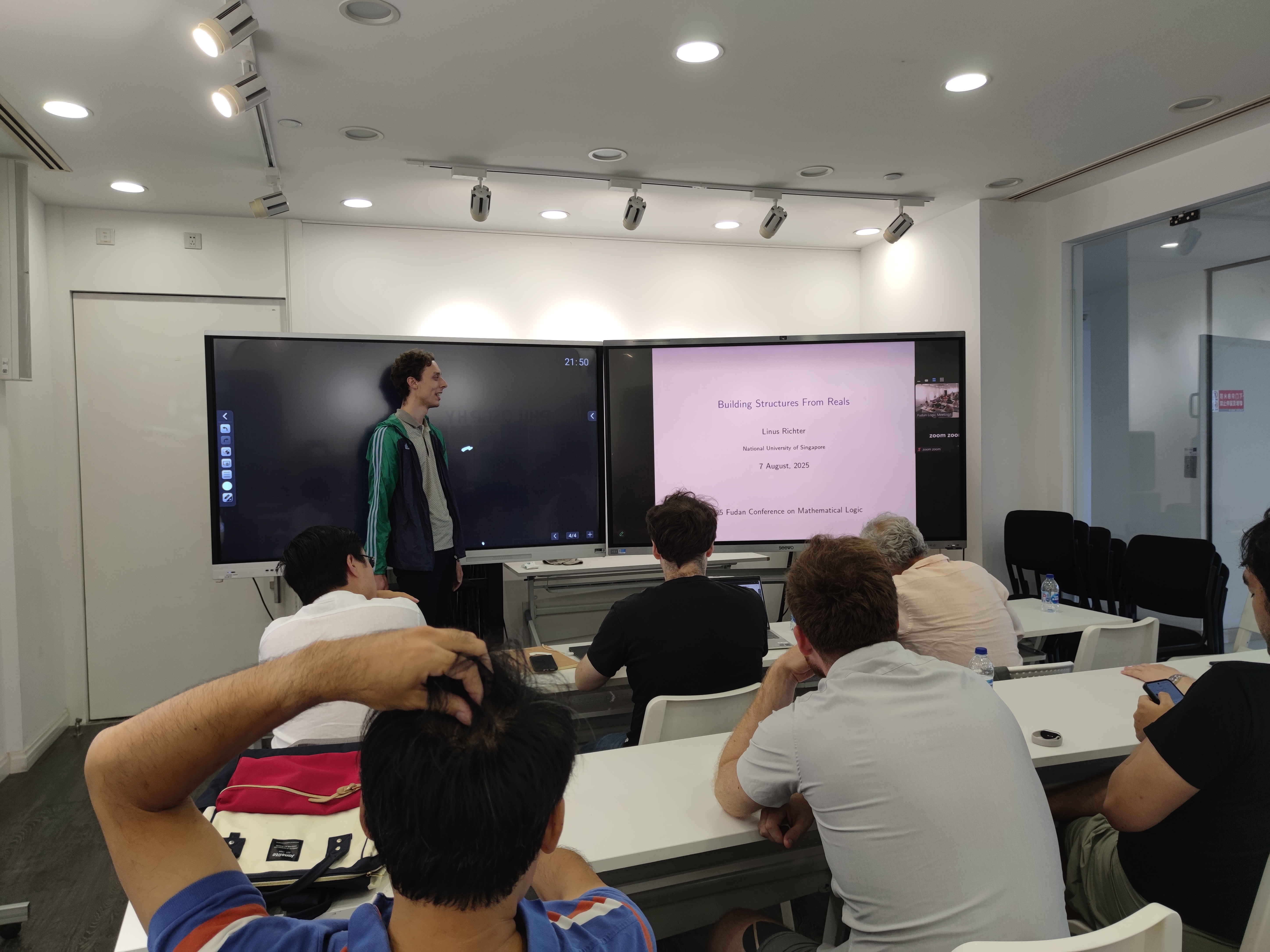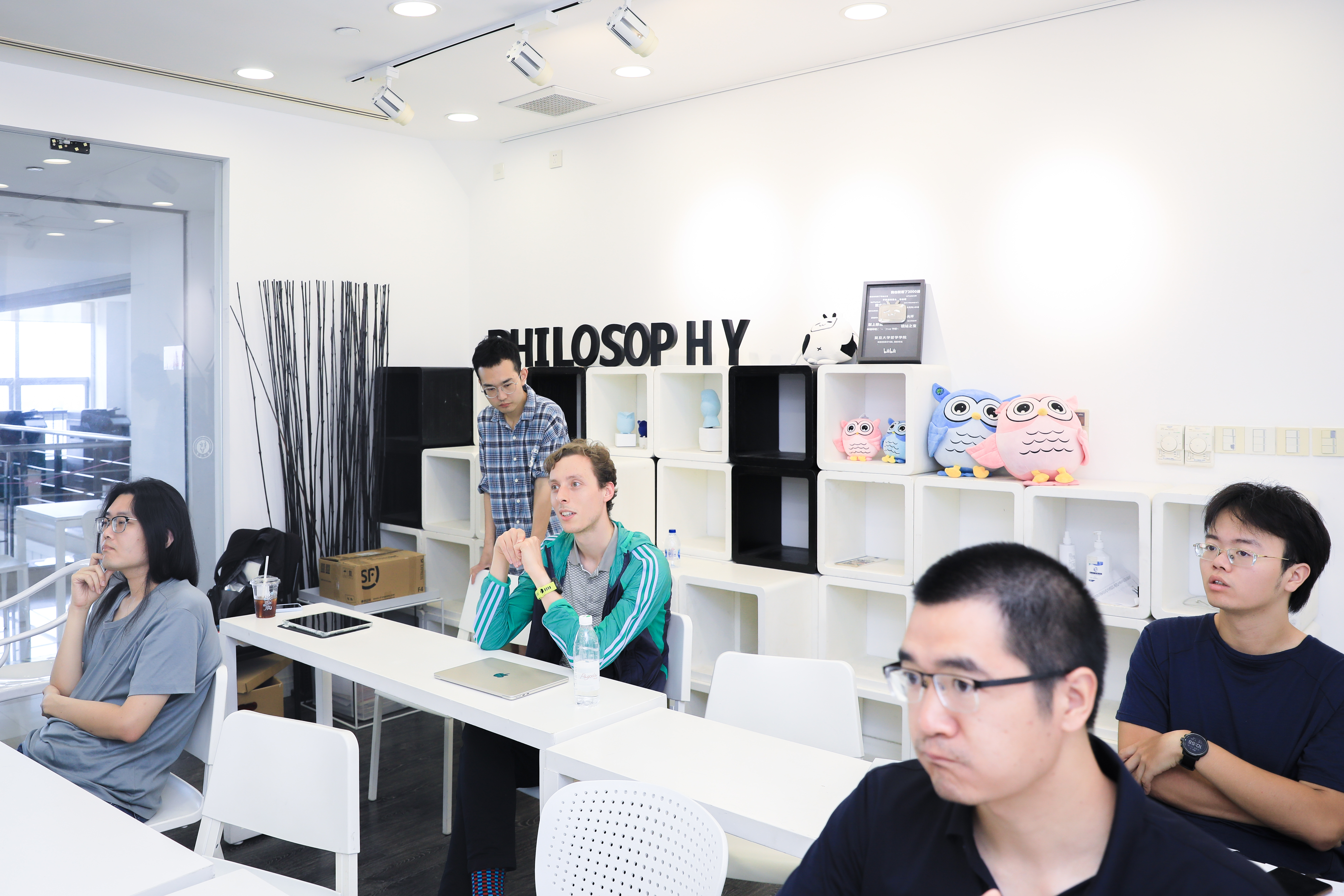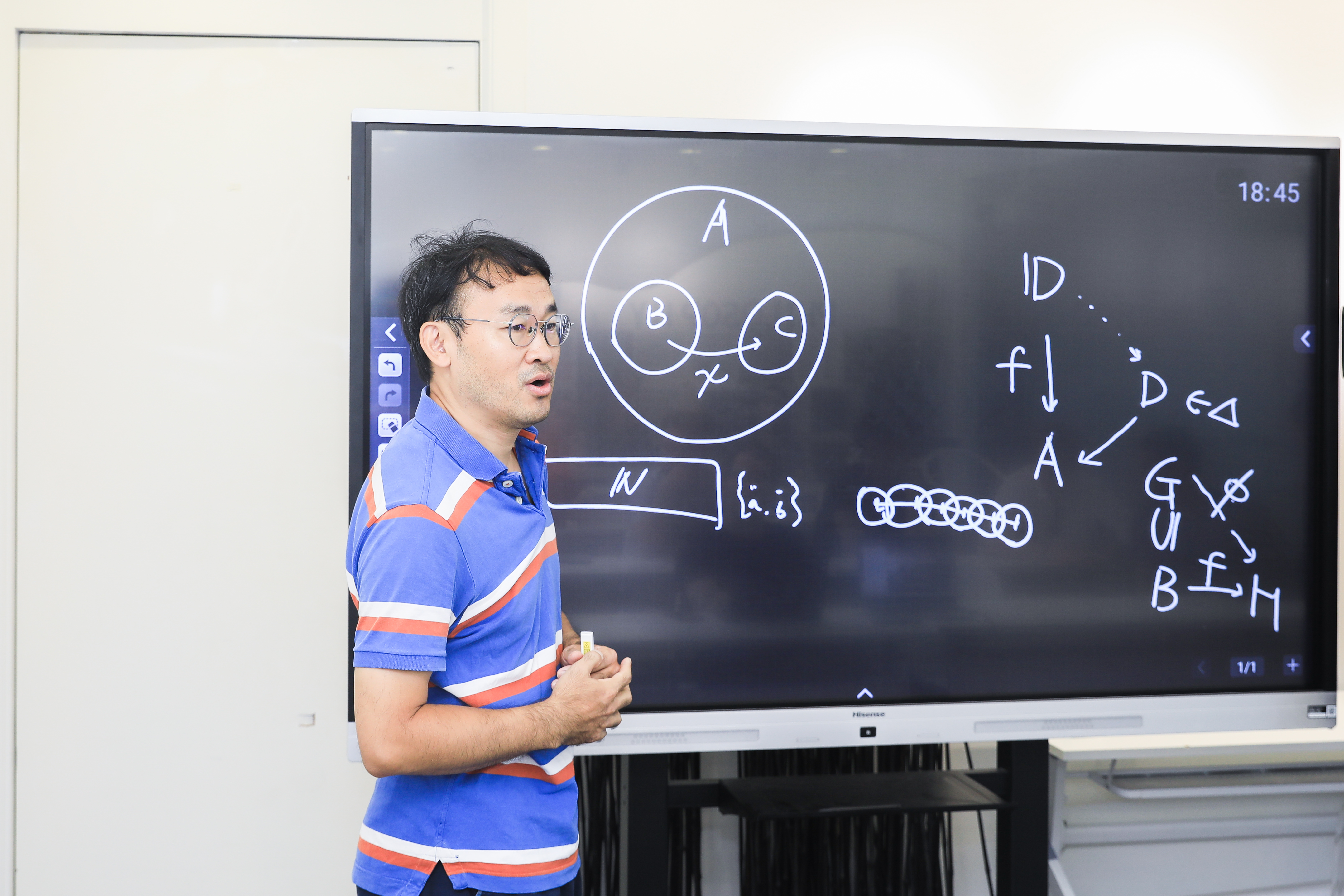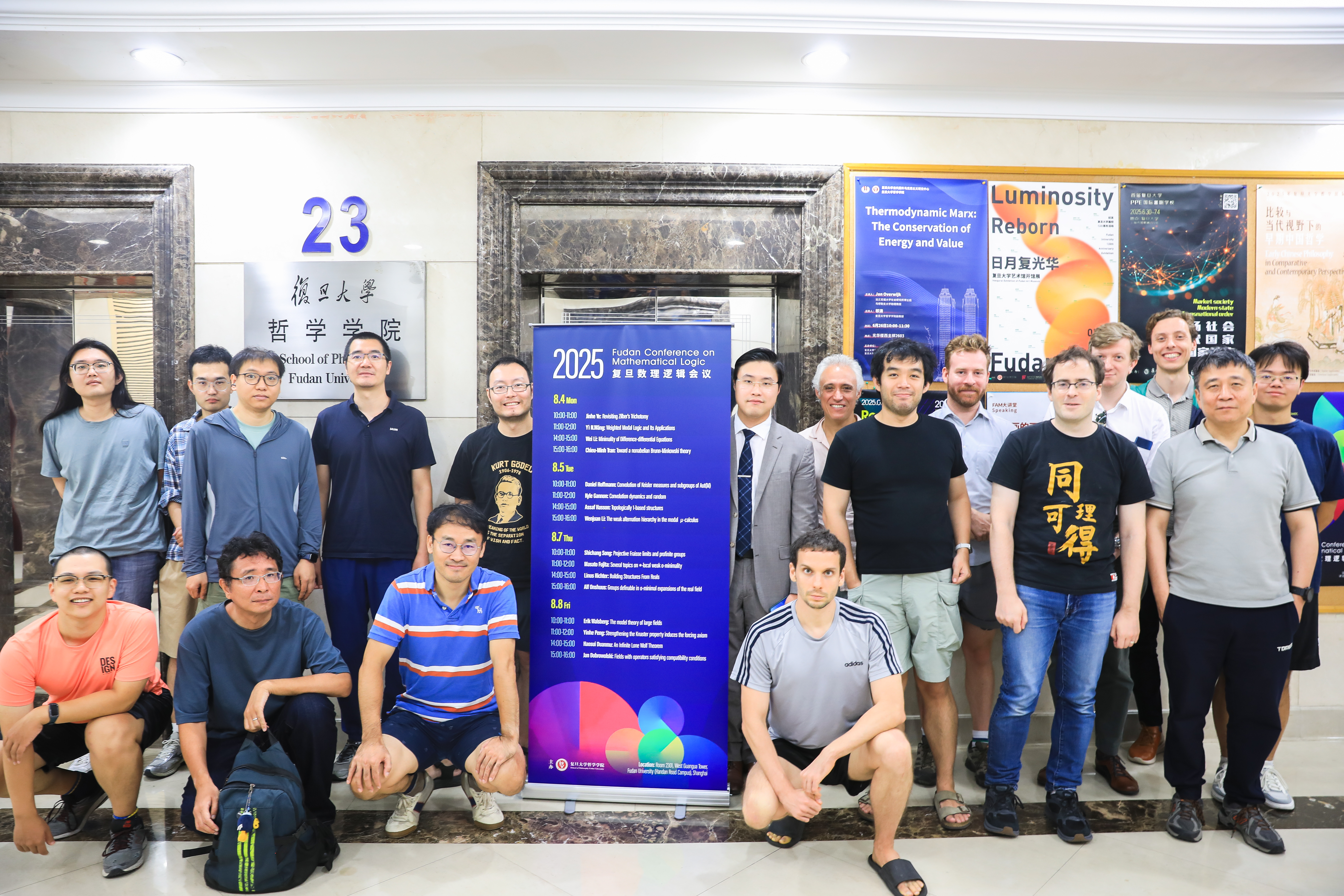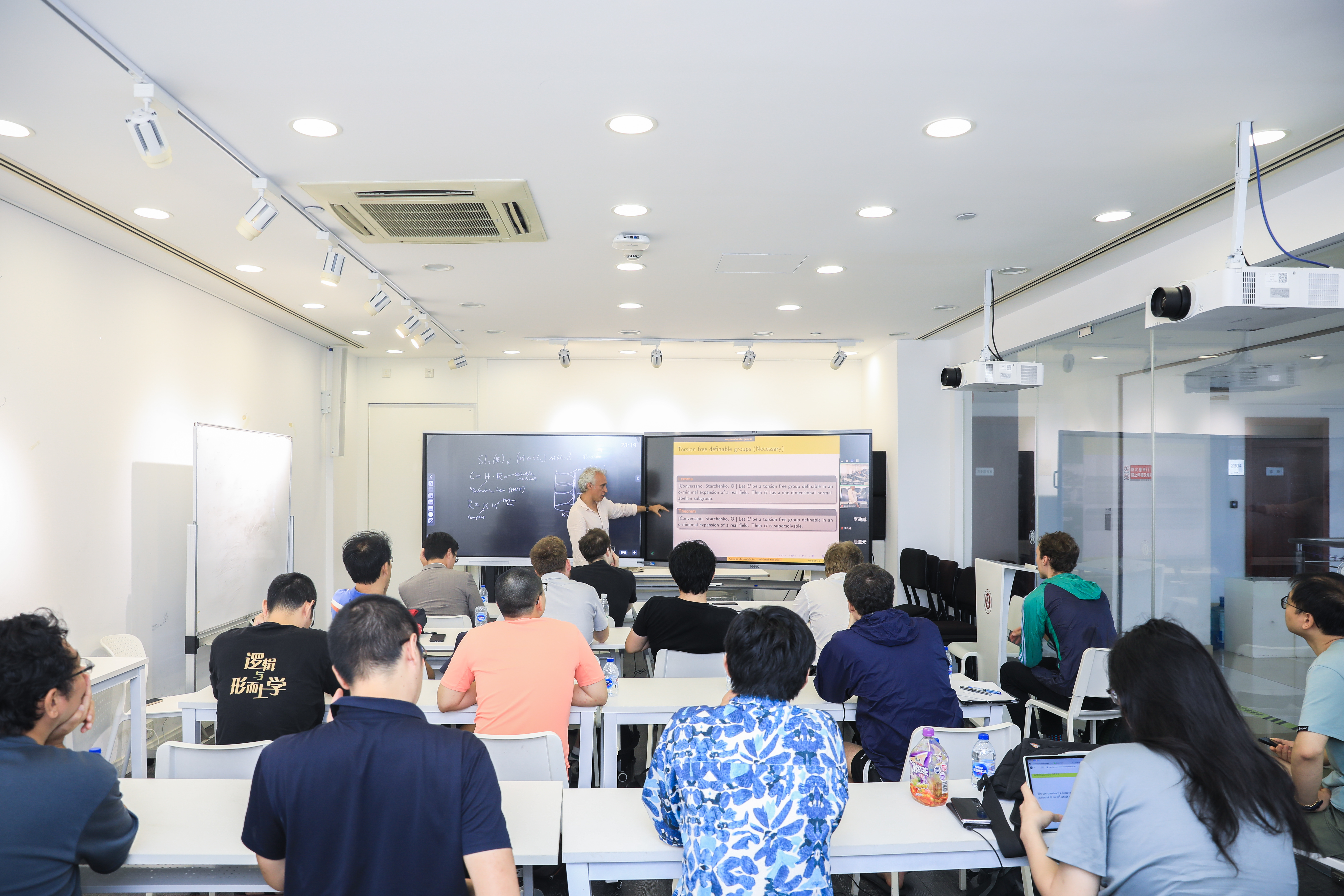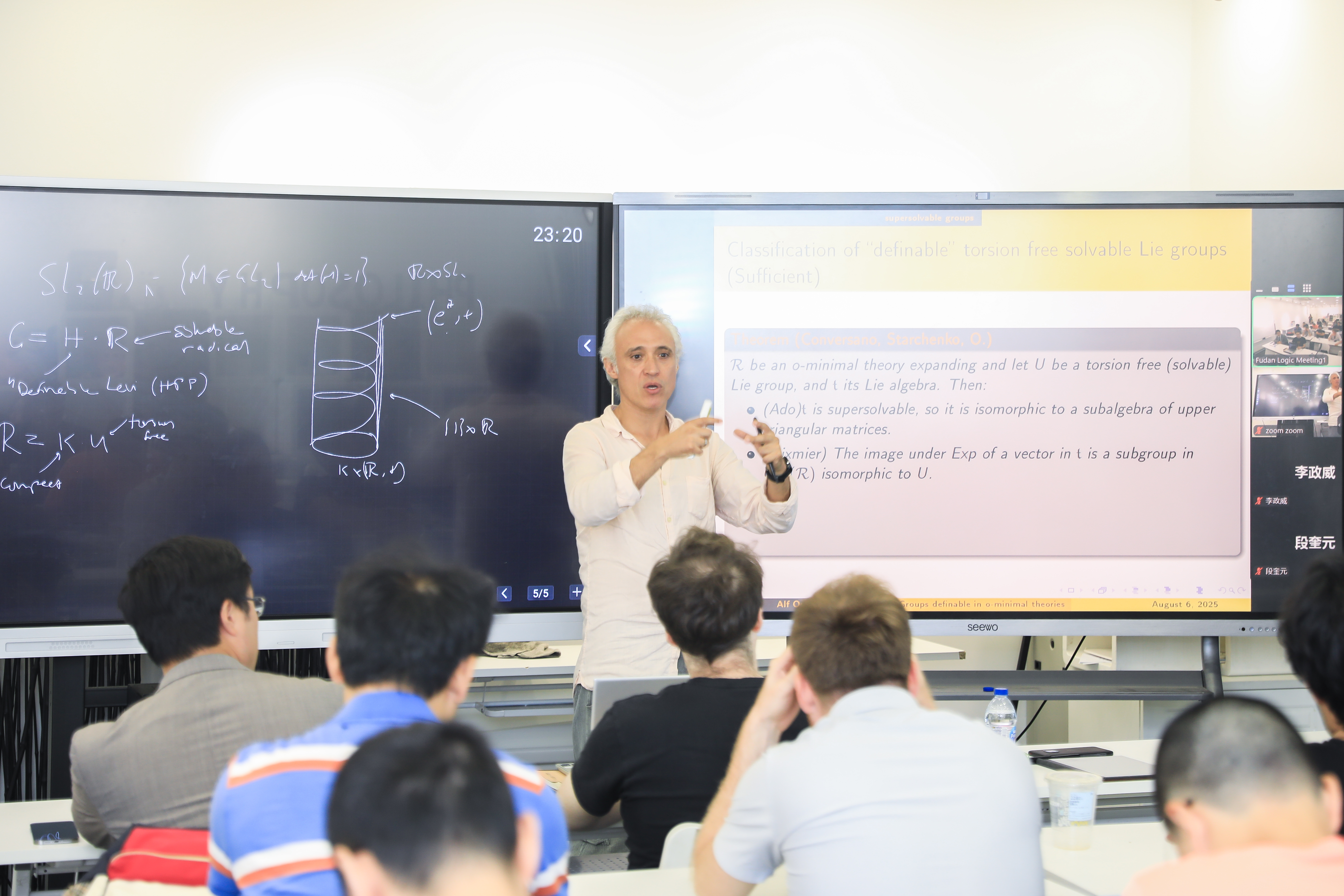2025 Fudan Conference on Mathematical Logic
2025复旦数理逻辑会议
Registration
Time: August 4 to 8, 2025
Location: Room 2301, West Guangua Tower, Fudan University (Handan Road Campus), Shanghai
Zoom meeting ID: 876 9967 9434
This conference aims to bring together mathematical logicians, especially those who are interested in model theory and the foundation of mathematics. The talks will range over several topics:
- Pure model theory and its applications to mathematics
- Philosophy of mathematics and its interactions with model theory
- Interactions between philosophy, set theory, and recursion theory
The meeting will be in-person and online. There is no conference fee for this conference.
Confirmed Speakers
- Dobrowolski, Jan
- Duanmu, Haosui
- Fujita, Masato
- Gannon, Kyle
- Hasson, Assaf (Online)
- Hoffmann, Daniel
- Li, Wei
- Li, Wenjuan
- Onshuus, Alf
- Peng, Yinhe
- Richter, Linus
- Song, Shichang
- Tran, Chieu-Minh (Online)
- Wáng, Yì N.
- Ye, Jinhe
Participants
- Jorge Carrasco Coquillat
- Chieu-Minh Tran
- Daniel Max Hoffmann
- 敦志刚
- 端木昊随
- Erik Walsberg
- 高众钦
- 郝兆宽
- 胡煜骐
- Jan Dobrowolski
- Kyle Gannon
- 李伟
- 李文娟
- 李羽旻
- Linus Richter
- Masato Fujita
- Mourad Berraho
- Alf Onshuus
- 裴志达
- 彭银河
- Prathapa Sayakkarage Harini Dissanayake
- 钱进
- 沈榆平
- 宋诗畅
- 王轶
- Will Johnson
- Xiang Li
- 杨睿之
- 杨云影
- 姚宁远
- 叶谨赫
- Assaf Hasson
Program (pdf file, updated on July 31)
Monday August 4
Zilber's Trichotomy Conjecture remains a central theme in model theory, offering a powerful lens through which to understand the geometry of definable sets in well-behaved contexts. Although numerous counterexamples exist, the conjecture continues to inspire fruitful investigation. In this talk, I will introduce a new axiomatic framework — Hausdorff Geometric Structures — that captures a broad range of contexts where the Trichotomy holds. This framework provides a unified approach to studying the trichotomy in such structures. Using this, we fully resolve the restricted trichotomy conjecture in the theory of algebraically closed fields. The talk is based on joint work with Ben Castle and Assaf Hasson. Slides
We extend classical modal logic by incorporating weighted structures into Kripke semantics for epistemic and doxastic applications. Weights represent agents' epistemic skills, such as expertise or resources, which influence their ability to distinguish possible worlds. This redefines the traditional indiscernibility relation as a weighted similarity relation, enabling reasoning about complex knowledge concepts like group knowledge, its dynamics, knowability, and forgetability. The framework also allows inference of epistemic skills from an agent's knowledge or ignorance.
Building on prior work, this study advances modal logic's theoretical foundations and offers practical tools for analyzing epistemic and social phenomena. For instance, it connects to rough set theory, broadening its interdisciplinary applications. The framework also extends to temporal, deontic, and preference logics. Slides
We analyze the behavior of systems of algebraic differential equations when considered as systems of difference-differential equations, with special emphasis on systems which define strongly minimal sets relative to the theory DCF$_{0,n}$ of differentially closed fields of characteristic zero with $n$ distinguished commuting derivations. We show that if $X$ is a strongly minimal set relative to DCF$_{0,n}$ defined by a finite system of algebraic partial differential equations and the forking geometry on $X$ is trivial (also called "disintegrated"), then $X$ remains minimal when regarded as definable set relative to the theory DCFA$_{0,n}$ of difference-differentially closed fields of characteristic zero with $n$ commuting derivations. We illustrate this theorem by describing the possible difference-differential equations consistent with differential equations of the form $y' = f(y)~$ where $f$ is a monic cubic polyomial over differential constants. This is a report on joint work with Thomas Scanlon. Slides
The Brunn-Minkowski theorem tells us that if \(\lambda\) is the Lebesgue measure on \(\mathbb{R}^d\) and \(A, B \subseteq \mathbb{R}^d~\) are compact with positive measure, then \[ \lambda(A+B)^{1/d} \ge \lambda(A)^{1/d} + \lambda(B)^{1/d}, \] and the equality holds if and only if \(A\) and \(B\) are homothetic convex sets.
In this talk I will discuss how this result can be seen through the lens of model theory, which is helpful towards generalizing it to locally compact groups. I will also explain the motivation from additive combinatorics, namely, part of the long quest to obtain the nonabelian counterpart of the Polynomial Freiman-Ruzsa Conjecture.
(Based on joint work with Yifan Jing, Simon Machado, and Ruixiang Zhang)
Tuesday August 5
In the talk, I plan to explain the main goals and results from my project with Kyle Gannon and Krzysztof Krupiński. We introduce a new product of types and Keisler measures, which is closely related to the action of $\mathrm{Aut}(M)~~$ on the space of types. In fact, our idea for the product comes from an isomorphism theorem which we obtained at the beginning of the project. In the theorem, we shift the structure of an Ellis semigroup to some space of Keisler measures (i.e. regular Borel probability measures on a space of types). After that, we generalize the definition of the product and call it $*$-product. The semigroup of types equipped with $*$-product is interesting on its own and encodes important properties of the theory, but in my talk I will focus more on the main conjecture from our project, which---roughly speaking---states that there is a bijective correspondence between idempotent Keisler measures (idempotent with respect to the $*$-product) and closed subgroups of $\mathrm{Aut}(M)~~$. We already know that this conjecture holds in all stable theories, in NIP theories with an additional KP-invariance assumption on the measures, and for types in all rosy theories.
This talk will be continued in Kyle Gannon's talk.
Around 15 years ago, Newelski first observed a fundamental link between the model theory and dynamics. Since then many researchers have studied this connection is some form or another. Much of this research can be divided into studying two distinct group actions on certain spaces of types: (1) definable group actions or (2) automorphism group actions. We remark that while these settings are distinct and use different techniques, they also enjoy a kind of symmetry. Results on one side can inspire one to prove analogues results on the other.
Over the last 5 years, Chernikov and myself (and later also with Krupiński) have studied a random variant of definable group actions. In this context, points are replaced with probability measures and multiplication is replaced with (definable) convolution. In the NIP setting, the theory is quite pleasant and there are many structure theorems. A priori, it is unclear how to define an anologue of definable convolution in the automorphism setting. In recent work with Krupiński and Hoffmann, we have developed an automorphism group analogue, completing the picture.
This talk is a continuation of Daniel Hoffman's talk. Slides
We define the notion of a topologically 1-based structure, adapting the analogous stability theoretic concept in the setting of t-minimal structures with the independent neighbourhood property. For geometric t-minimal structures, topological 1-basedness coincides with weak 1-basedness (studied by Bernstein and Vassiliev). We prove that non-trivial topologically 1-based structures admit a type-definable topological group that is locally linear (in an appropriate sense) and locally abelian. These results apply, in particular, to dense C-minimal structures, and to densely ordered weakly o-minimal theories.
Joint work with Ben Castle. Handout
The modal $\mu$-calculus extends propositional modal logic by adding least and greatest fixed-point operators. The alternation hierarchy classifies modal $\mu$-formulas based on the nesting of mutually dependent least and greatest fixed-point operators in formulas. To capture its alternation-free fragment, we introduce the notion of the weak alternation hierarchy, which is closely related to weak parity games, weak tree automata, and the one-variable fragment of the modal $\mu$-calculus. We show that, over infinite binary trees, the weak alternation hierarchy up to transfinite levels exhausts the class $\Delta^{\mu}_2 = \Sigma^{\mu}_2 \cap \Pi^{\mu}_2~$ within the modal $\mu$-calculus. This an ongoing joint work with Prof. K. Tanaka. Slides
Wednesday August 6
Excursion in Shanghai: Shanghai Museum East, Shanghai Tower, the Bund, Yuyuan.
Thursday August 7
We show that the projective Fraisse limit of the class of finite groups is the free profinite group on a countably infinite set converging to 1. Then we will discuss the automorphism groups of such profinite groups. Joint work with Sulin Hu. Slides
Definably complete locally o-minimal structures enjoy several tame properties such as a local version of monotonicity theorem and several simple formulas for dimension function. However, locally o-minimal structures without definable completeness are possibly wild.
First, the presenter proved that a variant of local monotonicity theorem holds in every locally o-minimal structure in which univariant functions definable enjoy a strong continuity property called the univariate $*~$-continuity property. Second, the presenter proposed a subclass of local o-minimality called $*~$-local weak o-minimality. In this subclass, the univariate $*~$-continuity property is equivalent to that dimension function satisfies a tame formula called addition formula, which is a generalization of a similar fact in weakly o-minimal structures.
The notion of $*~$-local weak o-minimality is related to a combinatorial model theoretic notion "of finite burden". In fact, the presenter proved that a nonvaluational expansion of an ordered Abelian group of finite burden defining no nonempty subset which is dense and condense in a univariate definable open set is $*~$-locally weakly o-minimal. Slides
I will outline recent applications of (higher) computability theory and definability in the context of geometric measure theory and set theory. These centre on constructing both classical (e.g. subsets of Euclidean space) and set-theoretical structures (e.g. sequences of elementary submodels) from real numbers, using their Turing-computability-theoretic properties. Slides
We will give an account of groups definable in o-minimal expansions of the real field. We will refer to these groups, both in this abstract and in the talk, as definable groups. The talk will include an overview of the main o-minimal expansions of the real field together with the main open conjectures. We will then focus on the structure of groups definable in some o-minimal expansion of the real field, talking about the main properties, components and invariants. We will give necessary and sufficient conditions for a real Lie group to have a Lie-isomorphic to a definable group. And if there is time, we will give necessary and sufficient conditions for when one can add a continuous isomorphism between two definable groups to the theory preserving o-minimality. Slides Handout
Friday August 8
I will introduce large fields, discuss examples, describe the topological approach to largeness, and outline the proof of a recent result on their model theory. Slides
A poset (partially ordered set) $\mathcal{P}$ has property K$_n$ (K for Knaster), for $n\geq 2~$, if every uncountable subset of $\mathcal{P}$ has an uncountable subset that is $n$-linked where a subset is $n$-linked if every $n$-element subset has a common lower bound. It is easy to see that K$_{n+1}$ implies K$_n$.
We show that the reverse implication has the same strength as MA$_{\omega_1}$(K$_n$), Martin's axiom for posets with property K$_n$. More precisely, for $n\geq 2~$, if every poset with property K$_n$ has property K$_{n+1}~$, then MA$_{\omega_1}$(K$_n$) holds.
Consequently, $\mathscr{K}_3$ implies MA$_{\omega_1}$, i.e., MA$_{\omega_1}$ holds if every ccc poset has property K$_3$. Slides
Since Gale and Shapley, economists have studied stable outcomes in two-sided matching markets and the deferred acceptance (Gale-Shapley) algorithm, which finds a stable outcome. The Lone Wolf Theorem illustrates a desirable property of the set of stable outcomes, namely that the set of unmatched agents does not depend on the choice of stable outcome. Classical matching theory has assumed that the set of agents is finite. In this talk, we generalize the Lone Wolf Theorem to the infinite setting. Slides
I will report on a recently-finalised work with O. Leon Sanchez in which we prove that if $\mathcal{D}$ is a local algebra, then the theory of fields with $\mathcal{D}$-operators satisfying a general compatibility condition is always companionable in characteristic zero, and is companionable in positive characteristic if the maximal ideal of $\mathcal{D}$ coincides with the kernel of the Frobenius homomorphism on $\mathcal{D}$. In characteristic zero, we prove some desirable properties of the model companion, such as stability, the Canonical Base Property, and Zilber's dichotomy for finite-dimensional types.
Examples falling into our framework include the theory of fields with commuting $\mathcal{D}$-operators, the theory of fields with Lie-commuting derivations, the theory of fields with iterative Hasse-Schmidt derivations, and, more generally, the theory of fields with finite group scheme actions. Slides
Lecture hall: West Guangua Tower Room 2301
- Hao, Zhaokuan
- Johnson, Will
- Yang, Ruizhi
- Yao, Ningyuan
Email: yaony@fudan.edu.cn, willjohnson@fudan.edu.cn, logic@fudan.edu.cn
